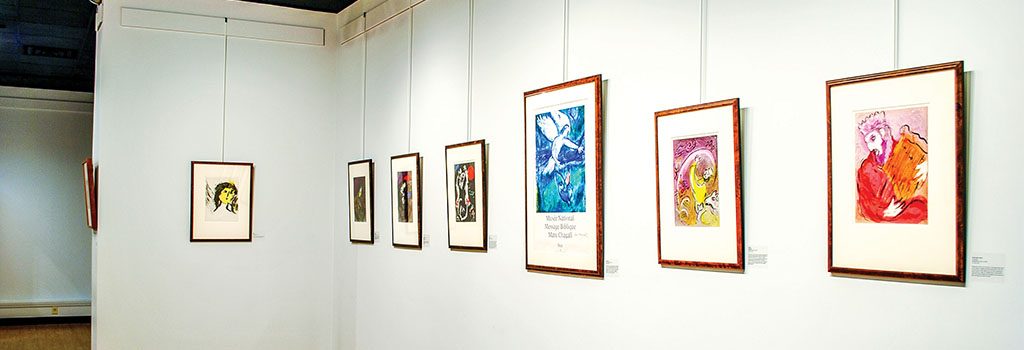- Liberty University’s Green Hall Art Gallery brings unconventional, biblically inspired work by Marc Chagall.
- Chagall collection from a collection from artist Sandra Bowden, who wants to bring more art with Christian connections to Liberty.
Moses has horns protruding from his head.
Abraham and Sarah have a bright blue skin tone.
Jesus Christ is a clock.
Unconventialism comes to campus with the Green Hall Art Gallery’s “Marc Chagall & The Bible,” where the abstract and Semitic collide in Russian-Jewish artist Marc Chagall’s whimsical interpretations of biblical scenes.
A contemporary of 20th century pioneers like Henry Matisse and Pablo Picasso—and very good friends with both—Chagall rocked the art world with his vibrant colors, bizarre symbolism and a religion that heavily influenced his work.
He also refused to adhere to any certain form or medium, and his repertoire of nearly 10,000 pieces ranged from murals on New York City’s Metropolitan Opera House to 12 stained-glass windows (representing the tribes of the Old Testament) at an Israeli hospital.
Though he always incorporated his Jewish roots in his art, Chagall only began depicting the Bible after an inspiring trip to Jerusalem in 1931. He created dozens of etchings until 1939, and didn’t resume the series until the early 1950s. In 1956, French art journal Verve commissioned Chagall to create a series of lithographs, which he finished in 1960.
The exhibition, which arrived Aug. 15, comprises 36 pieces of Chagall’s work. It’s only a fraction of the 105 etchings and 24 lithographs that depict stories the artist had been hearing since childhood
Green Hall Art Gallery Director Todd Smith arranged the art, which predominantly features the Old Testament, in chronological order, beginning with a portrait of the angel that drove Adam and Eve from the Garden of Eden and ending with the crucifixion of Jesus Christ. Featured in between are figures like Esther, Moses and Ruth.
But the subject matter isn’t what made Chagall’s work profound, but rather how—and why—he depicted it.
Smith noted that Chagall revolutionized the Christian art world by offering a new, abstract perspective. It was just what the church needed, Smith said.
“Back then, depictions of stories from the Bible were very realistically painted,” Smith said. “But (the church) wanted to make the church…and the art used by the church more relevant to the culture. What they loved was that (Chagall) could speak to the contemporary culture.”

In addition to his vibrant colors and wild, spontaneous lines, the artist is renowned for his heavy use of symbolism. Upside down birds, floating people and faces at odd angles are only a few of his signature symbols.
Sandra Bowden, an artist herself who collected and loaned out the exhibition from the Bowden Collection, said these symbols are pulled from the artist’s personal experiences and represent themes and motifs from the Bible.
“They’re very personal, and he’s sharing that,” Bowden said. “Each of the symbols are symbolic of some biblical entity as he saw it. It’s his own visual vocabulary, his own theological descriptions.”
The information placards next to each painting, written by Bowden, are intentionally limited when it comes to the meaning behind these cryptic images.
“It was left for us to discover its meaning too,” Bowden said. “Art is a language you learn how to decipher, how to read, how to interpret.”
Bowden and Smith had been in communication since before the gallery showcased Bowden’s work in October 2016. She stressed the importance of the Christian university hosting more world-renowned artists.
“Liberty [has] a huge student body and a very large art department,” Bowden said. “They need to have a connection with the giants in Christian art.”
According to Bowden, Chagall’s significance in a Christian context lies in the devout religion from which he never parted, despite the shame often associated with Judaism during Chagall’s time.
“He’s a man who went through an awful lot, a Jewish person who lived under great pressure,” Bowden said, adding that his village was eventually destroyed by the Nazis. “And yet that faith was central to the day he died.”
Bowden’s ultimate goal in art collecting is to impact the Christian community. The Bowden Collection consists of 14 different collections that constantly travel the country.
“I don’t do it for the money,” Bowden said. “It’s a ministry. I love it.”
She hopes to eventually bring to Liberty artists like French-Catholic impressionist Georges Rouault and Japanese-Christian printmaker Sadao Watanabe.
“I want to make sure the young people and the Christian community have the opportunity to come up close, study these artists and be inspired by them,” Bowden said.
The Chagall exhibition will remain at Liberty until Oct. 14, after which it will travel to St. Georges Episcopal Church in Nashville, Tennessee.
